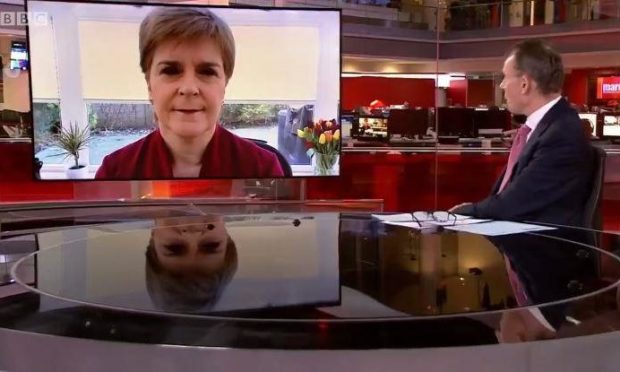It would, of course, be ridiculous to describe Nicola Sturgeon as weak. She is formidable, imperious, even (whisper it) Thatcheresque in her dominance of Cabinet, parliament, party, movement and country.
If the First Minister were a company she would be Amazon – a market-devouring behemoth that has somehow slipped the usual rules of competition and accountability.
Nevertheless, the SNP’s announcement at the weekend of an 11-point roadmap to an independence referendm carries with it an unfamiliar hint of, if not weakness, then certainly a weakening of the first minister’s grip.
Catalonia conundrum
The party now proposes, if it wins a majority in May, to legislate for an independence referendum even if Boris Johnson refuses to sanction one. This opens the way to a controversial Catalonia-style nationwide vote, held without UK government authorisation.
Given Johnson’s implacability over indyref2, it’s not hard to see why the Nats are stepping up hostilities. They will push on with their preparations and if the British government has a problem with that, they’ll see them in court. If Westminster won’t bend, well, Scotland might just vote anyway.
But this is more than just a change in tone from Sturgeon. For the past few years, she has resisted the rebels in her own party who have been pushing for a Plan B to be drawn up. This group has grown tired of what they see as Sturgeon’s caution, her autocratic style of rule, and the small leadership clique around her and her husband, SNP chief executive Peter Murrell. Many of the rebels are also close to Sturgeon’s predecessor Alex Salmond, and believe he is the victim of a conspiracy that landed him in court on charges of sexual harrassment. They would be happy to see his successor toppled, despite the damage it would do to the cause.
To ordinary voters this civil war – and behind the scenes it is nastier and more vicious than is publicly visible – is bizarre. The SNP has never been closer to its goal: poll after poll is producing majorities in favour of independence. Sturgeon is having a “good” Covid pandemic, winning trust and growing in authority. Boris Johnson is not. Scots who voted No in 2014 and Remain in the 2016 Brexit referendum have found their attachment to the UK undermined by the country’s departure from the EU.
Not easily bought off
But political parties are not regular workplaces. They seethe with rivalry and frustrated ambition, with individuals who have both strong opinions, outsize egos and an overblown sense of their own destiny. The SNP’s famous discipline and unity have broken down.
Sturgeon, it seems, has caved at last. The new plan is an attempt to whip the movement back into line, to provide focus and momentum when both appear to be faltering. The message is clear: this circular firing squad is crazy – the common enemy is Westminster.
Will it be enough to satisfy her critics? Joanna Cherry, the SNP MP who is the first minister’s fiercest internal opponent and who has been pushing hard for a Plan B, tweeted a cautious welcome. But, she added: “I have many questions about the detail of this new strategy… and the proposed timetable.” Cherry, an ally of Salmond’s, will not be easily bought off, and nor will her fellow rebels.
While internal SNP politics count, there is the small matter of the electorate. People are labouring under yet another lockdown, struggling to balance working from home with home-schooling, worried about their health and that of their relatives and friends, uncertain about their jobs and their economic security. Some will wonder whether the Scottish government shouldn’t have more urgent priorities than another independence referendum.
There is a precedent for the SNP misjudging public sentiment. In early 2017, not long after the Brexit vote, Sturgeon announced that Britain’s departure from the EU was the “material change in circumstances” the SNP needed to call a second indyref. Within the Nationalist bubble this may have seemed a logical progression. For ordinary Scots it looked self-serving and obsessive, as if Sturgeon was trying to rush them out of the UK. Come the general election in June that year, the SNP lost 21 of its 56 seats. Voters wouldn’t be taken for granted.
It is possible a similar view will be taken of this latest scramble. Support for independence is of course higher than it was in 2017, and the Nats seem to be Teflon-coated, but fighting Covid and the economic recovery remain urgent and unfinished tasks.
The SNP have returned to familiar old territory, where the answer to any challenge is always independence. Perhaps this time the voters will agree, and perhaps not. Regardless, weakness, not strength, has forced Sturgeon’s hand.
Chris Deerin is a leading journalist and commentator who heads independent, non-party think tank Reform Scotland

